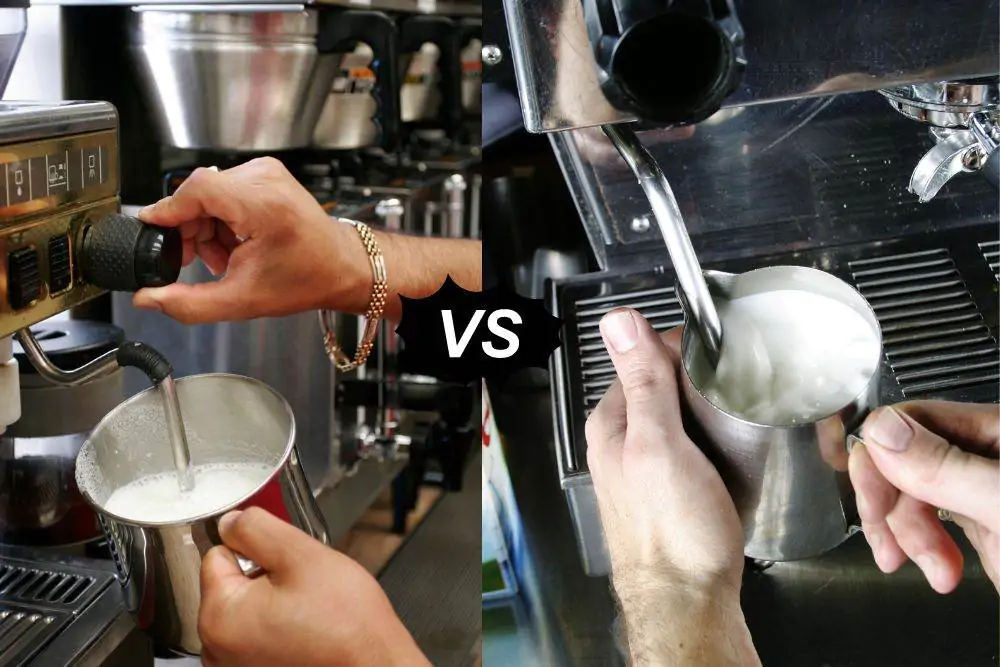Adding milk to your coffee can make it smoother and tastier. But, the question is: milk frothing vs steaming? Figure out which method works best with our guide!

Now that I’ve become a certified coffee drinker, I’ve started to incorporate more milk into my beverages. There was a time when I would simply pour some into my latte or mocha in the morning, but now I’ve become something of a milk connoisseur.
So, instead of taking a jug of cold milk and adding it to my coffee, I prefer either steamed or frothed milk. At first, they may seem identical, but there are some crucial differences. So, I’ve decided to explore those distinctions here. Join me in looking at milk frothing vs steaming, won’t you?
What Is Frothed Milk?
Another word for this kind of milk is foamed milk, which should give you an idea of what to expect. Frothing is the process of adding a bunch of air to the liquid for the explicit purpose of creating foam.
Milk foams well because it has fat and protein. As a rule, the fattier the milk, the stronger the bubbles. However, there has to be a delicate balance between the fats and proteins to ensure a smoother, easier process. For example, whole milk can create rich, decadent foam, but it’s hard to do because the extra fat can break the bubbles too easily.
How To Froth Milk

You might think that you need a special frothing wand to create milk foam. While the device does make frothing easier, it’s not always necessary. For a more straightforward method, just heat the milk to around 130 degrees, either in a microwave or stovetop.
You don’t want to overheat it as that will burn the milk and make it mildly bitter. Once it’s at the right temperature, you can shake the milk in a jar or use an immersion blender (or frothing wand) to create foam. Overall, you’re just trying to add as much air to the milk as possible so that it creates thicker bubbles.
What Is Steamed Milk?
Technically speaking, you could say that all frothed milk is steamed milk, but not the other way around. Steamed milk is simply a version of frothed milk that doesn’t have as much foam. Instead of thick, creamy bubbles, you get microfoam or tiny air bubbles.
Steamed milk is easier to pour since it has a smoother, denser consistency. If you want to make latte art, steamed milk is the best choice.
How To Steam Milk

While you could use a steam wand or an espresso machine to steam your milk, a regular microwave or saucepot will do the trick. That said, you can burn milk, which separates the proteins and makes it taste bitter. So, we recommend using a thermometer to ensure you get the right temperature.
What Are The Differences Between Frothed Milk And Steamed Milk?
Beyond the creation process for each type of milk, there are some unique differences, such as:
Temperature
Frothed milk can be hot or cold, while steamed milk has to be served hot.
Foam Thickness
Typically, frothing milk produces lots of foam, which can shake and wobble easily. Steamed milk, however, is closer to a liquid.
Milk Preference
Since frothed milk needs large bubbles, liquids with more fat and protein are easier to use (i.e., two-percent milk). All milk can be steamed, including alternative varieties like almond or coconut milk.
When To Use Frothed Milk
Since the foam is the star of the show, it works best with some types of coffee (and hot chocolate). The most common beverages that use milk foam include:
- Cappuccino
- Latte
- Espresso
- Americano
- Macchiato
When To Use Steamed Milk
Realistically, you can use steamed milk instead of foam for all the coffees listed above (including hot chocolate). However, steamed milk is better for poured latte art, like the kind you see on social media. Since steamed milk is easier to pour, you have much more flexibility and versatility.
However, you need to work quickly before the milk cools off and the microfoam dissipates.
The Final Word On Milk Frothing Vs Steaming
Personally, I like both milk options in my coffee. If I’m making my morning beverage at home, I typically steam the milk since it’s easier to do. I don’t mess around with artistic designs; I’m just trying to smooth out the bitterness of the beans.
However, when I buy a cup of Joe from a coffee shop, I like to get frothed milk instead. I appreciate the taste of a rich, creamy foam on top, and I don’t mind getting a frothy mustache. Overall, both options work well, so it comes down to your preference.
FAQ About Milk Frothing Vs Steaming
Which milk is best for frothing?
Typically, oat milk, almond milk, or two-percent milk work best for frothing. However, skim milk can also generate some thick foam.
Which milk is best for steaming?
All milk can be steamed easily since the foam doesn’t have to be as stable. If you use milk alternatives, steaming is much more convenient.
Does the age or temperature of my milk matter?
Yes, you want fresher milk for frothing, so the proteins are more stable. Cold milk also works better than room-temperature liquid.

